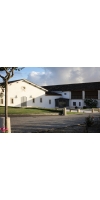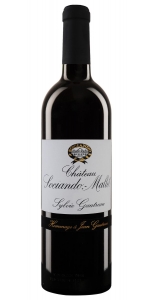Wine from Sociando

Château Sociando-Mallet is located in the commune of Saint-Seurin-de-Cadourne, ten kilometres north of Pauillac, in the Haut-Médoc appellation. A document dating from March 1633 refers to land here belonging to an aristocrat of Basque origin named Sociondo. A member of his family was Bishop of Bayonne. Another document, from 1750 mentions vines belonging to Demoiselle Anne de Sossiondo. Due to various misspellings over the years, "Sossiondo" became "Sociando".
Jean Gautreau discovered Sociando-Mallet when looking for a wine estate to buy on behalf of a Belgian client. It was love at first sight, despite the fact that the property was in a sorry state. However, the terroir was excellent and the domain afforded a magnificent view overlooking the Gironde Estuary. There were only 5 hectares of vines at the time. The buildings were in bad shape and there was no barrel cellar – just a small vat room and garage. With help and advice from Gérard Cler, a previous employee at the château, Jean Gautreau made an acceptable first vintage and a superb second one. He was helped by the fact that Sociando-Mallet's extraordinary terroir, consisting of Günz gravel with clay subsoil, is propitious to growing excellent Cabernet Sauvignon and producing wines with wonderful freshness. Jean Gautreau expanded the vineyard year after year by buying vines from his neighbors. Seeking the best possible quality, he also renovated the estate’s buildings, built a barrel cellar, and gradually improved the choice of grape varieties, matching the appropriate ones to each vineyard plot.
Today, the property stretches over a total of 120 hectares, of which 83 are under vine. Jean Gautreau sold his négociant business in 2000 to focus on managing his wine estate. He passed away in October 2019, leaving his daugther and only child Sylvie the property she had been managing since 2015. She favours viticultural methods close to nature, following in her father’s footsteps, with the same love and respect of the land. She can be found participating in the various technical tastings and choosing the blend with her team.
Sociando Mallet Haut-Medoc is made from 53% Merlot, 46% Cabernet Sauvignon and 1% Cabernet Franc.
Château Sociando-Mallet produces full-bodied wines with a deep, dark color. The complex bouquet is dominated by red and black fruit aromas with a touch of minerality, floral and spicy notes. Fresh, harmonious and nicely balanced in the mouth with a solid tannic structure and good acidity that promises a long aging potential. The mid-palate is pleasant with a nice density of fruit. A silky and fruity finish.
Red meat, dishes in sauce, poultry, strong goat or cow cheeses.
- back
Selected Options
Wineries
Categories
Pricing
Countries
Regions
Grape Types
Wineries
Organic/Free Shipping
Paul Hobbs Chardonnay Russian River Valley is made from 100 percent Chardonnay.
Crafted with precision from six pedigreed sites comes a wine that beams with pale straw hue. The newest vintage brings wonderful aromatic intensity: candied lemon peel, white florals followed by crisp green apple. A creamy and viscous texture on the palate is buoyed by white nectarine and dried apricot that’s balanced with a vibrant acidity, bringing focus to the wine’s finish that lingers with hints of flinty mineral notes.
Review:
Patrimony Caves des Lions is made from 65% Cabernet Sauvignon, 35% Cabernet Franc.
With an inky ruby color, the 2020 Caves des Lions offers elegant aromas of chocolate-covered espresso beans with nuanced layers of blueberries, savory notes of charcuterie, pipe tobacco, and woodsmoke. This festival of flavors continues on the palate with notes of fresh fruit, cayenne pepper, plum jam, and pomegranate. The bold tannins seamlessly balance the fresh and rounded acidity leading to an unwavering finish. This full-bodied and flawlessly intricate wine will surprise you now with its elegance, and later with its longevity.
Reviews:
"Inviting aromas of black and blue fruits with violets, cedar, crushed stones and graphite. A little minty, too. The impressive, compact tannin structure gives depth to the wine, so fine and polished with some chalky texture to it. Stony minerality. Power and delicacy, simultaneously. 65% cabernet sauvignon and 35% cabernet franc. Really long and precise."
-James Suckling 97 Points





